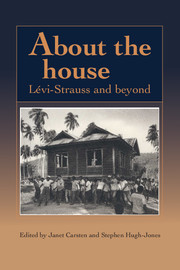Book contents
- Frontmatter
- Contents
- List of illustrations
- List of contributors
- 1 Introduction
- 2 Houses and hierarchies in island Southeast Asia
- 3 The resurrection of the house amongst the Zafimaniry of Madagascar
- 4 The hearth-group, the conjugal couple and the symbolism of the rice meal among the Kelabit of Sarawak
- 5 Houses in Langkawi: stable structures or mobile homes?
- 6 Having your house and eating it: houses and siblings in Ara, South Sulawesi
- 7 The Lio House: building, category, idea, value
- 8 Houses and hierarchy: the view from a South Moluccan society
- 9 Houses, places and people: community and continuity in Guiana
- 10 The houses of the Mẽbengokre (Kayapó) of Central Brazil – a new door to their social organization
- 11 Inside-out and back-to-front: the androgynous house in Northwest Amazonia
- Notes
- Bibliography
- Index
3 - The resurrection of the house amongst the Zafimaniry of Madagascar
Published online by Cambridge University Press: 05 June 2012
- Frontmatter
- Contents
- List of illustrations
- List of contributors
- 1 Introduction
- 2 Houses and hierarchies in island Southeast Asia
- 3 The resurrection of the house amongst the Zafimaniry of Madagascar
- 4 The hearth-group, the conjugal couple and the symbolism of the rice meal among the Kelabit of Sarawak
- 5 Houses in Langkawi: stable structures or mobile homes?
- 6 Having your house and eating it: houses and siblings in Ara, South Sulawesi
- 7 The Lio House: building, category, idea, value
- 8 Houses and hierarchy: the view from a South Moluccan society
- 9 Houses, places and people: community and continuity in Guiana
- 10 The houses of the Mẽbengokre (Kayapó) of Central Brazil – a new door to their social organization
- 11 Inside-out and back-to-front: the androgynous house in Northwest Amazonia
- Notes
- Bibliography
- Index
Summary
The zafimaniry are a group of Malagasy swidden cultivators living in high-altitude montane forest. In terms of general culture they are fairly close to the neighbouring Betsileo or even the Merina. Their political history has been characterized by their determined attempts to avoid various forms of centralized government, attempts which on the whole have been fairly successful.
The only period when the Zafimaniry suffered tight government control followed the Madagascar-wide anti-colonial revolt of 1947 when the French army probably killed at least 80,000 people. The best detailed study of this revolt remains Jacques Tronchon's L'Insurrection Malgache de 1947 (1974), but it would not be appropriate for the purposes of this chapter to give a general account of the events here.
The revolt affected the Zafimaniry particularly badly. This is largely because of their geographic position. The largest contingent of the rebel army had grouped on the coast to the east of them and then marched up to the central plateau in order to attack the larger towns in the centre of Madagascar. They chose to do this through the least accessible parts of the east coast forest in order to avoid detection and that meant through Zafimaniry country. The rebels and what they had to say was mostly well received by the Zafimaniry although I think very few Zafimaniry actually joined them. Nonetheless it is significant that to this day no Zafimaniry I know ever refers to the rebels of 1947 by the normal Malagasy word for ‘rebel’, which in their dialect has negative connotations, but they use instead another term with positive connotations.
- Type
- Chapter
- Information
- About the HouseLévi-Strauss and Beyond, pp. 69 - 83Publisher: Cambridge University PressPrint publication year: 1995
- 50
- Cited by

